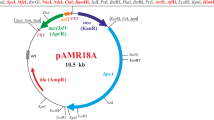Abstract
Thirteen strains of colorless, filamentous, gliding bacteria, at least five of which are sulfide oxidizers, were screened for the presence of plasmid DNA. Agarose gel electrophoresis revealed that the sulfide oxidizing Beggiatoa alba strains B15LD (ATCC 33554), B18LD (ATCC 33555), and B25RD (ATCC 33556) each contained plasmids having molecular masses of ca. 12.8x106. Analysis of the EcoRI restriction endonuclease fragment patterns showed that the 12.8x106 plasmids in these three strains were similar. A single 8.1x106 plasmid was detected in cleared lysates of the mixotrophic sulfide oxidizer, Thiothrix nivea JP3. Two plasmid DNA bands were detected in cleared lysates of Beggiatoa spp. L-1401-2. Four plasmid DNA bands were detected in Vitreoscilla stercoraria strains ATCC 15218 and VT1. Plasmid DNA was not detected in the Beggiatoa strains ATCC 15551 and PD1, or in Vitreoscilla spp. 389 and V. beggiatoides B23SS. No apparent correlation was observed between the presence of certain plasmids and sulfide oxidation.
Similar content being viewed by others
Abbreviations
- Tris:
-
tris(hydroxymethyl)aminomethane
- EDTA:
-
ethylenediaminetetraacetic acid, disodium salt
- TE:
-
Tris-EDTA
- TEA:
-
Tris-EDTA-acetate-NaCl
- TES:
-
Tris-EDTA-NaCl
- CCC:
-
covalently closed circular
- OC:
-
open circular
- L:
-
linear
- SDS:
-
sodium dodecyl sulfate
- ATCC:
-
American Type Culture Collection
References
Burton SD, Morita RY (1964) Effect of catalase and cultural conditions on growth of Beggiatoa. J Bacteriol 88:1755–1761
Cataldi M (1940) Aislamento de Beggiatoa alba en cultivo puro. Rev Inst Bacteriol Malbram (Buenos Aires) 9:393–423
Crosa J, Falkow S (1981) Plasmids. In: Gerhart P (ed) Manual of methods for general bacteriology. American Society for Microbiol, Wash, D.C., pp 266–282
Davis RW, Botstein D, Roth JR (1980) Advanced bacterial genetics. Cold Spring Harbor Laboratory, Cold Spring Harbor, NY
Faust L, Wolfe RS (1961) Enrichment and cultivation of Beggiatoa alba. J Bacteriol 81:99–106
Freidberg D, Seijffers J (1979) Plasmids in two cyanobacterial strains. FEBS Lett 107:165–168
Güde H, Strohl WR, Larkin JM (1981) Mixotrophic and heterotrophic growth of Beggiatoa alba in continuous culture. Arch Microbiol 129:357–360
Guerry P, LeBlanc DJ, Falkow S (1973) General method for the isolation of plasmid deoxyribonucleic acid. J Bacteriol 116:1064–1066
Helling RB, Goodman HM, Boyer HW (1974) Analysis of endonuclease R EcoRI fragments of DNA from lambdoid bacteriophages and other viruses by agarose-gel electrophoresis. J Virol 14:1235–1244
Hohn B, Collins J (1980) A small consmid for efficient cloning of large DNA fragments. Gene 11:291–298
Humphreys GO, Willshaw GA, Anderson ES (1975) A simple method for the preparation of large quantities of pure plasmid DNA. Biochim Biophys Acta 383:457–463
Kleinschmidt AK (1968) Monolayer techniques in electron microscopy of nucleic acid molecules. In: Grossman L, Moldave K (eds) Methods in enzymology, vol XII, nucleic acids, part B. Academic Press, New York, pp 361–377
Kowallik U, Pringsheim EG (1966) The oxidation of hydrogen sulfide by Beggiatoa. Amer J Bot 53:801–806
Kupersztoch YM, Helinski DR (1973) A catenated DNA molecule as an intermediate in the replication of the resistance transfer factor R6K in Escherichia coli. Biochem Biophys Res Commun 54:1451–1459
Larkin JM (1980) Isolation of Thiothrix in pure culture and observation of a filamentous epiphyte on Thiothrix. Current Microbiol 4:155–158
Mao MWH, Dugan PR, Martin PAW, Tuovinen OH (1980) Plasmid DNA in chemoorganotrophic Thiobacillus ferrooxidans and T. acidophilus. FEMS Microbiol Lett 8:121–125
Martin PAW, Dugan PR, Tuovinen OH (1981) Plasmid DNA in acidophilic, chemolithotrophic thiobacilli. Can J Microbiol 27: 850–853
McDonell MW, Simon MN, Studier FW (1977) Analysis of restriction fragments of T7 DNA and determination of molecular weights by electrophoresis in neutral and alkaline gels. J Mol Biol 110:119–146
Meyers JA, Sanches D, Elwell LP, Falkow S (1976) Simple agarose gel electrophoretic method for the identification and characterization of plasmid deoxyribonucleic acid. J Bacteriol 127:1529–1537
Murray K, Murray NE (1975) Phage lambda receptor chromosomes for DNA fragments made with restriction endonuclease III of Haemophilus influenza and restriction endonuclease I of Escherichia coli. J Mol Biol 98:551–564
Nelson DC, Castenholz RW (1981) Organic nutrition of Beggiatoa sp. J Bacteriol 147:236–247
Pringsheim EG (1949) The relationship between bacteria and Myxophyceae. Bacteriol Rev 13:47–97
Pringsheim EG (1951) The Vitreoscillaceae: A family of colourless, gliding, filamentous organisms. J Gen Microbiol 5:124–149
Pringsheim EG (1964) Heterotrophism and species concepts in Beggiatoa. Amer J Bot 51:893–913
Ratcliff SW, Luh J, Ganesan AT, Behrens B, Thompson R, Montenegro MA, Morelli G, Troutner TA (1979) The genome of Bacillus subtilis phage SPP1: The arrangement of restriction endonuclease generated fragments. Molec Gen Genet 168:165–172
Schrempf H, Bujard H, Hopwood D, Goebel W (1975) Isolation of covalently closed deoxyribonucleic acid from Streptomyces coelicolor A3(2). J Bacteriol 121:416–421
Scotten HL, Stokes JL (1962) Isolation and properties of Beggiatoa. Arch Mikrobiol 42:353–368
Simon RD (1978) Survey of extrachromosomal DNA found in the filamentous cyanobacteria. J Bacteriol 136:414–418
Strohl WR, Larkin JM (1978a) Cell division and trichrome breakage in Beggiatoa. Current Microbiol 1:151–155
Strohl WR, Larkin JM (1978b) Enumeration, isolation, and characterization of Beggiatoa from freshwater sediments. Appl Environ Microbiol 36:755–770
Strohl WR, Cannon GC, Shively JM, Güde H, Hook LA, Lane CM, Larkin JM (1981a) Heterotrophic carbon metabolism by Beggiatoa alba. J Bacteriol 148:572–583
Strohl WR, Geffers I, Larkin JM (1981b) Structure of the sulfur inclusion envelopes of four beggiatoas. Current Microbiol 6:75–79
Strohl WR, Howard KS, Larkin JM (1982) Ultrastructure of Beggiatoa alba strain B15LD. J Gen Microbiol 128:73–84
Sutcliffe JG (1978) pBR322 restriction map derived from the DNA sequence: accurate DNA size markers up to 4361 nucleotide pairs long. Nucleic Acid Res 5:2721–2728
Thuring RWJ, Sanders JPM, Borst P (1975) A freeze-sequeeze method for recovering long DNA from agarose gels. Anal Biochem 66:213–220
Webster DA, Hacket DP (1966) Respiratory chain of colorless algae. II. Cyanophyta. Plant Physiol 41:599–605
Author information
Authors and Affiliations
Rights and permissions
About this article
Cite this article
Minges, C.G., Titus, J.A. & Strohl, W.R. Plasmid DNA in colorless filamentous gliding bacteria. Arch. Microbiol. 134, 38–44 (1983). https://doi.org/10.1007/BF00429404
Received:
Accepted:
Issue Date:
DOI: https://doi.org/10.1007/BF00429404




